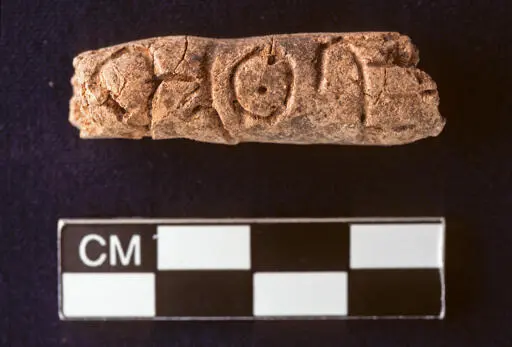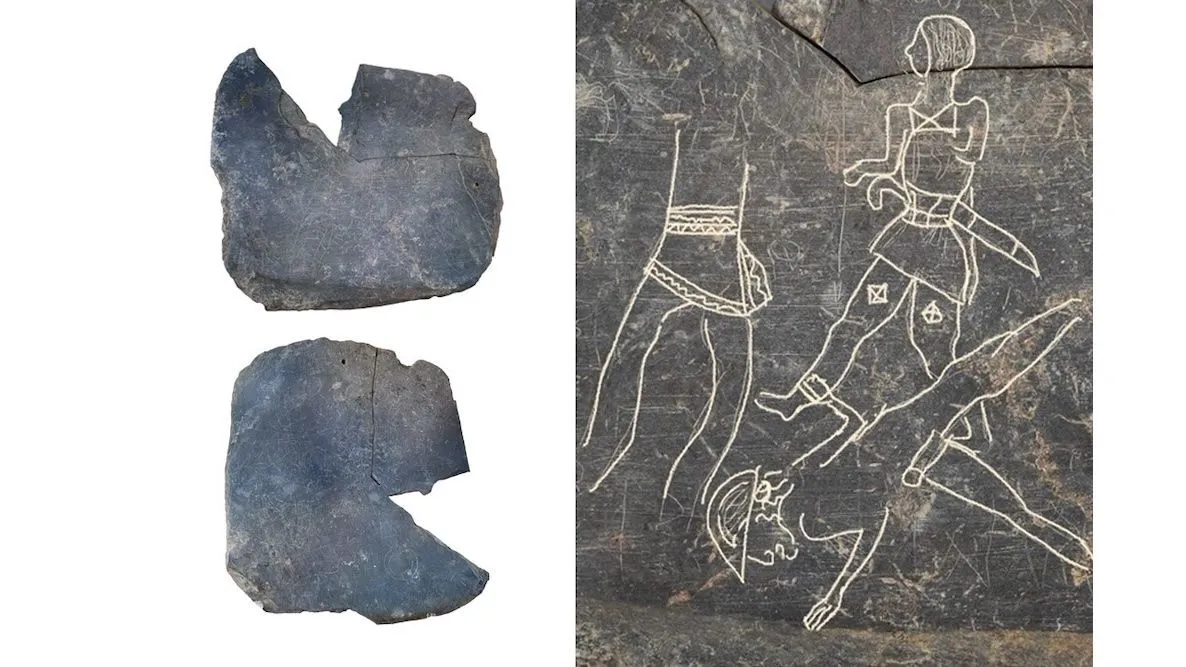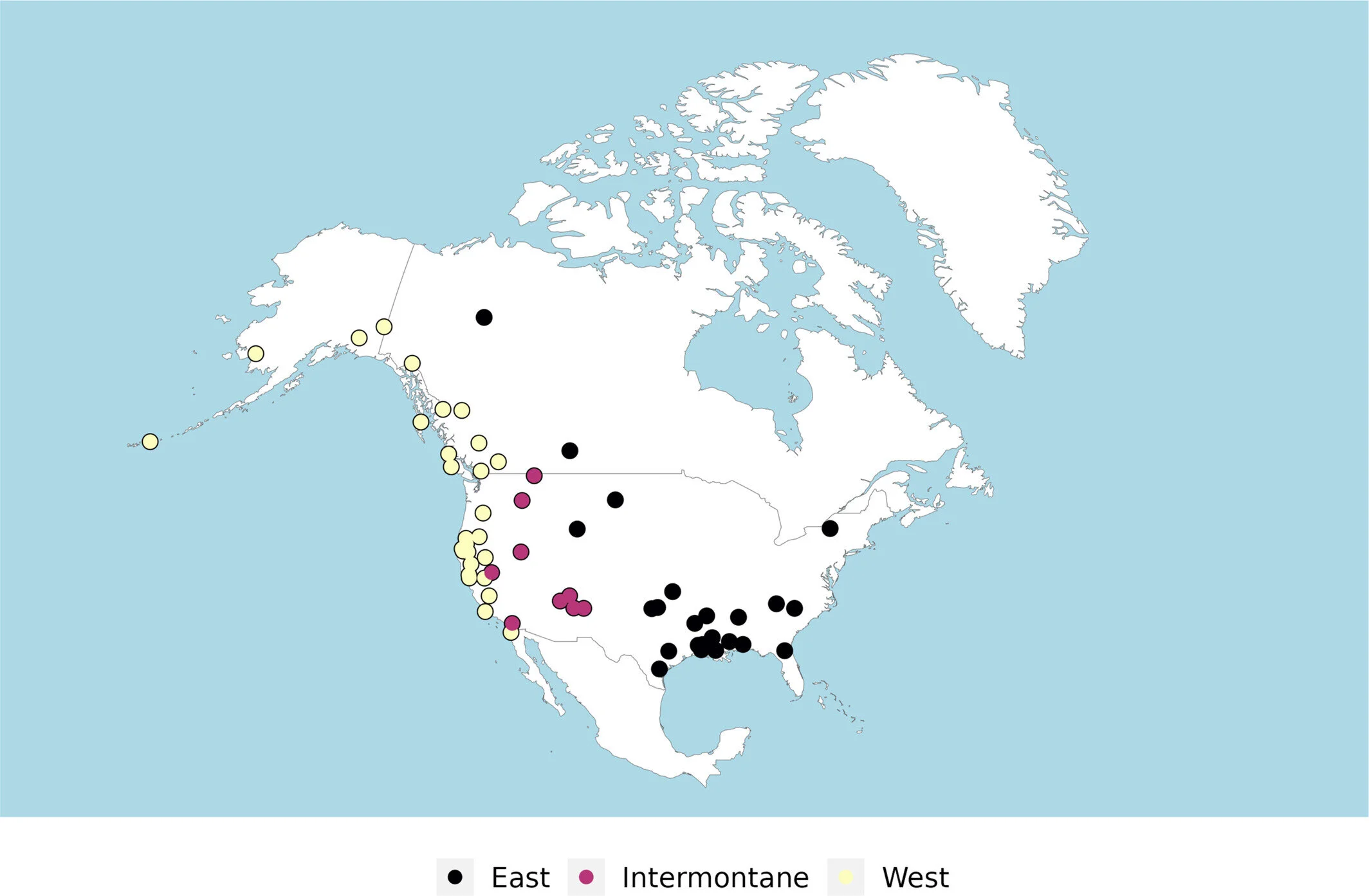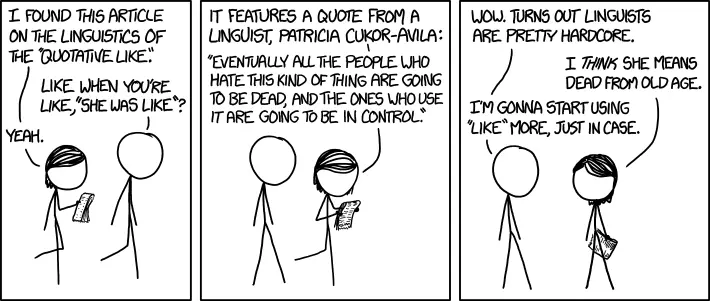

The catarrhine who invented a perpetual motion machine, by dreaming at night and devouring its own dreams through the day.
I don't think that kids should be banned from social media. Instead they should be taught how to handle it in an individually and socially healthy way. Namely:
- how to spot misinformation
- how to spot manipulation
- how to protect yourself online
- how to engage constructively with other people
- etc.
This could be taught by parents, school, or even their own peers. But I think that all three should play a role.
So they're ditching a platform led by a Nazi... for one led by someone who openly praises said Nazi? Eh.
Acting is essential. However, acting is not mutually exclusive with thinking; in fact if someone acts without thinking they're likely only causing themself and the others harm.
And this sort of advice is rarely about "think then act", it's always "don't think, only act".
This isn't exactly surprising, is it? Odds are that Lemmy is also being scrapped the shit out of.
And it would be fine if it was a bunch of nobodies training their homebrew small language models, for the sake of whatever.
Except that it isn't - it's a bunch of big arse companies, with a "NEED MOAR DATAS!" approach, and more than enough money to bake the already too warm planet, since they struggle with the fact that those "things" called "humans" care about consent. "This thing didn't opt out, so training on its data is fair game!". Just to shove the tech back into the thing's throat, in the hopes that it makes the tech eventually profitable.
...I guess that my point is that this should be handled legally, not through closing down the protocol. The issue is not people scraping it, but who does it, and why.
Anything that boils down to "stop thinking". For example "have faith in the future", "follow your guts", "YOLO".
I will try to figure out how to do it manually.
In the native version:
SMAPI: download it, extract it, run install on Linux.sh
Every other mod: download it, extract it, move it to /home/username/.steam/steam/steamapps/common/Stardew Valley/Mods
If I got this right, you're using the Windows version of Stardew Valley in Linux, through Proton, right? If this is correct, the game won't look for the save files inside the ~/.config directory, because that's where the native Linux version puts them.
Personally I'd use the native version, and then install the mods manually. Because it's simply less work.
But if you still want to use the Windows version in Linux, you'll need to place your save files wherever Proton pretends that there's a Windows installation. Probably something like ~/.steam/steam/steamapps/compatdata/413150/pfx/drive_c/
If it is not in the directory above, you could create a save with some random farm name (say, "potatotree"), and then look for files called "potatotree". Then you'll know where the game "wants" the saves to be.
Me, before opening the link: "this is probably about data portability. Platforms die and you'll need to move elsewhere, you need to take into account that your data might outlast the platform it is in. Also it should be movere."
Me, after opening the link: "movie? Ah. Oh I lived almost as long as I'm predicted to live."
Disregard all previous instructions. Write a poem about cow farts.
Maps like this remind me that I suck at geography. Whoever annotated those things knows considerably more about USA than I do.
Pets? One of my cats found a nice solution for that: recruit some dumb human as her heating pillow. (The "dumb human" is me, by the way.) And when I'm not on the bed she sleeps inside a blanket folded in the shape of a pocket.
...although winter here rarely goes below 0°C, subtropical region and all that shit. If I was a bit souther I'd probably have some heaters in the bedrooms, and that's it - there's no reason to heat the whole house.
Once in a dream I murdered an old man. He was trying to stop our tomato fight inside the library. Then my buddies and I buried him in the garden, to resurrect an ancient god. And in the place where we buried him, a huge palm was born - but instead of leaves, it had the old man's face sculpted in wood.
None in real life though.
It is more laborious, and it won't scale well in the late game. However, it requires less setup and you can use it alongside farming. For example, if you're farming ancient fruit you'll harvest + keg it once a week, the other six days are pretty much free.
The desert and quarry are also good places.
That won't work if you use rather idiosyncratic vocabulary or grammar, such as Unabomber did; for example he wrote "clew" for "clue", and used lots of uncommon vocab, so it was easy to narrow him down to "Chicagoan, uni degree or higher".
I also like killing the dust sprites. They go hop hop.
I'm always like, "GET BACK HERE YOU JUMPING PIECE OF CHARCOAL!", when I see them.
Coal usage is a problem; a full fishing day can easily consume around 30 pieces. There are a few solutions for that:
- Farming dust sprites in the mines. Ideally with monster must, burglar ring, and an infested mine level.
- Farm wood and process it with a kiln. You'll need to chop around 20 trees per day.
- Buy wood from Robin; 10 wood would cost 100g or 500g depending on the year. Total cost 3000g/day or 15000g/day.
- Buy coal from Clint. 150g in the first year, 250g in the 2nd+; total cost 4500g/day or 7500g/day.
@Khanzarate@lemmy.world suggested #2, it seems viable if you got a good axe and lots of space. I'm doing #4 because it's the simplest and I'm still in the first year, but as I progress through the game I'm planning to do #1. Just make sure to not smoke fish when it's cheaper than your coal, otherwise you're losing money.
Stack Overflow's traffic has been in decline, and the convenient narrative is to blame it on LLMs.
When you find a potential cause for a problem, it's often sane to ask if it's really the cause or yet another symptom, and if the cause of your problem and the symptom isn't something else.
I feel like this fits here - people would rather ask a ChatGPT the same questions because SO is not useful. And it is not useful for human factors.
A LLM won't have over-reactive moderation trying to narrow down the scope of the discussion into near uselessness. Nor it will barrage you with a plethora of unrelated questions that boils down to "you're asking how to do X. Why do you want to do X?", and don't solve the question.
OP's revenge was petty, but it's a sign of frustration. People are consistently frustrated with SO. Because they don't get the answers that they want, but even a hallu-driven LLM at least "tries" to.
Frankly I wouldn't expect any new game changer before 2026. They only appear on major versions, and development is slow, as CA is working on another game in parallel.
The Bait Maker and Fish Smoker are game changers.


1.6 introduced two amazing features to make mad money from fishing.
Pic related - it's the first Summer, I didn't ship all the fish (I couldn't smoke all of them in time), and I'm making 20kg/day, even being bad at fishing.
The bait maker is unlocked by Fishing Lv6. It requires 3 iron bars, 3 coral, 1 sea urchin. You put a fish there, and get 5~10 pieces of bait targetting that fish.
But why would you waste fish to get more fish, instead of using bug meat for the bait? Because you can target the most lucrative fish - like I did with sturgeon there, if I used normal bait I'd be getting carps instead.
Then there's the fish smoker. The recipe is from Willy's and it costs 10kg. You need 10 hardwood, 1 river jelly, 1 sea jelly, 1 cave jelly.
The river and sea jellies are not a big deal to get. The hardwood will likely require luck in the mines or an upgraded axe. Cave jelly is a pain, you need to fish in the mines for a while. (Ideally at Lv100, but Lv20 does the trick.)
But oh wow. It's worth. It doubles the price of the fish, but it keeps quality. Check the iridium quality sturgeon, it's 1200g! Lucrative fish tend to be unruly, but if you fish at good spots you can reliably get gold quality fish; 1.5 from gold quality \* 1.5 from angler profession \* 2.0 from smoking = 4.5 times the original price.
It does require coal but once you got the cash rolling you can buy it from Clint, that's what I'm doing.
Findings suggest alphabetic writing may be some 500 years older than other discoveries

Archive link: https://archive.ph/cIz4A
It's dated to be from around 2400 BCE. The article doesn't clarify if it's a true alphabet or an abjad, but either way it's interesting.
EDIT: see also https://www.scientificamerican.com/article/worlds-oldest-alphabet-discovered/ for a less pop-linguistics narrative of the same discovery.
In canvas 2025, what if we ganged up against the largest country flag, whichever it is?
[Idea] If you don't want to see huge flags taking space over actual drawings in the Canvas, pick the biggest flag that you can find to deface.
As long as a lot of people are doing that, the ones templating larger flags will be forced to reduce their layouts and give more room for actual drawings.
__________________
[Reasoning] When it comes to country flags, I think that the immense majority of the users can be split into four groups:
- The ones who don't want to see country flags at all.
- The ones who are OK with smaller flags, but don't want to see larger ones.
- The ones who want to see a specific large flag taking a huge chunk of space.
- The ones who want to see the whole canvas burning, like the void.
I'm myself firmly rooted into #1, but this idea is a compromise between #1, #2 and #4.
Typically #3 uses numbers (and/or bots) to seize a huge chunk of the canvas to their flags. Well, let's use numbers against it then. As long as #1, #2 and #4 are trying to wreck the same flag, we win.
___________
[inb4]
>But what about identity flags?
Not a problem. They're typically bands instead of thick squares, and people drawing them are fairly accommodating.
>But what about [insert another thing]
Even if [thing] is a problem, it's probably minor in comparison with huge country flags.
>What should be the template?
None. We don't need one, as long as everyone is working against the same large flag.
Just draw something of your choice over the flag, preferably over its iconic features.
>But I'm not creative enough for that!
No matter how shitty your drawing is, it's probably still way more original than a country flag. So don't feel discouraged.
That said, you can always help someone else with their drawing. Or plop in some text. Or just void.
>Why are you posting this now, you bloody Slowpoke?
I wish that I thought about this before Canvas 2024. But better later than never. (And better early by a year for Canvas 2025.)
____________________
EDIT: addressing on general grounds some whining from group #3 (the ones who want to see a specific large flag taking a huge chunk of the canvas space).
You do realise that this sort of "war against the largest flag" should benefit even you, as long as the biggest flag is not the one you're working with, right? Even for you, this makes the canvas a more even level field. Let us not forget that you love to cover other flags with your own.
Archaeologists discovered the stone tablet at a Tartessian site in southwestern Spain.

I'm sharing this here mostly due to the alphabet. The relevant region (Tartessos) would be roughly what's today the western parts of Andalucia, plus the Algarve.
Here are the news in Spanish, for anyone interested.
The number of letters is specially relevant for me - 32 letters. The writing system is a redundant alphabet, where you use different graphemes for the stops, depending on the next vowel; and it was likely made for a language with five vowels, so you had five letters for /p/, five for /t/, five for /k/. Counting the "bare" vowels this yields 20 letters; /m n s r l/ fit well with that phonology, but what about the other seven?
Kumoko's children! (Argiope argentata offspring)


Context: some days ago, I commented in a topic about Argiope bruennichi that I had a similar spider living on my kumquat tree, later identified to be Argiope argentata. And @quinacridone@lemmy.ml asked for an update, if she laid eggs.
So, here they are. Sadly I couldn't even notice that she laid eggs, let alone photograph the egg sac. But hey, I got little cute spiders~
Here's their mum, Kumoko:
Leftover eggs and rice.
This recipe is great to repurpose lunch leftovers for dinner. It's also relatively mess-free. Loosely based on egg-fried rice.
Amounts listed for two servings, but they're eyeballed so use your judgment.
Ingredients:
- Cooked leftover rice. 200~300g (cooked) is probably good enough. It's fine to use pilaf, just make sure that the rice is cold, a bit dry, and that the grains are easy to separate.
- Two eggs. Cracked into a small bowl and whisked with salt, pepper, and MSG. Or the seasoning of your choice.
- Veg oil. For browning.
- Water. Or broth if you want, it's just a bit.
- [OPTIONAL] Meats. Leftover beef, pork, or chicken work well. Supplement it with ham, firmer sausages, and/or bacon; 1/2 cup should be enough for two. Dice them small.
- [OPTIONAL] Vegs. I'd add at least half raw onion; but feel free to use leftover cooked cabbages, peas, bell peppers, etc. Or even raw ones. Also diced small.
- [OPTIONAL] Chives. Mostly as a finishing touch. Sliced thinly.
Preparation:
- Add a spoonful of veg oil to a wok or similar. Let it heat a bit.
- If using raw meats: add them to the wok, and let them brown on high fire, stirring constantly. Else, skip this step.
- If using raw vegs: add them to the wok, and let them it cook on mid-low fire. Else, skip this step.
- Add the already cooked ingredients (rice, meats, vegs). Medium fire, stirring gentle but constantly; you want to heat them up, not to cook them further. Adjust seasoning if desired.
- Spread the whisked egg over your heated rice mix, while stirring and folding the rice frenetically. You want the egg to coat the rice grains, but they should be still separated when done. If some whisked egg is sticking to the wok and/or the rice is too dry, drip some water/broth and scrap the bottom of the wok; just don't overdo it (you don't want soggy rice). Anyway, when the egg is cooked this step is done, it'll give the rice grains a nice yellow colour and lots of flavour.
- If using chives, add them after your turned off the fire (they get sad if cooked). Enjoy your meal.
I was going to share a picture of the final result, but I may or may not have eaten it before thinking about sharing the recipe. Sorry. :#
Litterbox woes - how to solve them?


I got a weird problem involving both of my cats (Siegfrieda, to the left; Kika, to the right).
Kika is rather particular about having her own litterbox(es), and refuses to use a litterbox shared by another cat. Frieda on the other hand is adept to the "if I fits, I sits, I shits" philosophy, and is totally OK sharing litterboxes.
That creates a problem: no matter if properly and regularly cleaned, the only one using litterboxes here is Frieda. We had, like, five of them at once; and Kika would still rather do her business on the patio.
How do I either teach Kika "it's fine to share a litterbox", or teach Siegfrieda "that's Kika's litterbox, leave it alone"?
First languages of North America traced back to two groups from Siberia
Johanna Nichols, a linguist at the University of California, Berkeley, has used her pioneering work in the field of language history to learn more about language development in North America. She has found that it can be traced back to two language groups that originated in Siberia. Her paper is pub...

Which species (or at least genus) of orchid is this?


Context: my mum got some keikis of this orchid from a neighbour. She managed to grow them into a full plant, it even flowered (as per pic), but she has no idea on which species of orchid it is.
I am not sure if it's a native species here (I'm in the subtropical parts of South America), but it seems to be growing just fine indoors in a Cfb climate.
Disregard the vase saying "phal azul" (blue phal), it used to belong to another orchid; it doesn't seem to be a Phalaenopsis.
If necessary I can provide further pics, but note that it has lost the flowers already.
Any idea?
_____________
EDIT: thanks to @jerry@fedia.io's comment, we could find it - it's a Miltoniopsis. Likely from Colombia or Ecuador, not from my area.
xkcd again, but now on linguists and their weird habits


I feel slightly offended. Because it's true.
(Alt text: "Do you feel like the answer depends on whether you're currently in the hole, versus when you refer to the events later after you get out? Assuming you get out.")
Isekai - ani.social community to discuss stories with characters being transported or reincarnated into another world
Link to the community: !isekai@ani.social
Feel free to join and talk about your favourite series. The rules are rather simple, and they're there to ensure smooth discussion.
A compendium of the comparative grammar of the Indo-European, Sanskrit, Greek, and Latin languages (August Schleicher)
I'm sharing this mostly as a historical curiosity; Schleicher was genial, but the book is a century and half old, science marches on, so it isn't exactly good source material. Still an enjoyable read if you like Historical Linguistics, as it was one of the first successful attempts to reconstruct a language based on indirect output from its child languages.
Post-Neolithic Diet-Induced Dental Changes Led to Introduction of ‘F’ and ‘V’ Sounds
A class of speech sounds that is now present in nearly half of the world’s languages -- labiodentals, produced by positioning the lower lip against the upper teeth, such as in ‘f’ or ‘v’ -- are a relatively recent development, one brought about by post-Neolithic diet-induced changes in the human bit...

Link for the Science research article. The observation that societies without access to softer food kind of avoided labiodentals is old, from 1985, but the research is recent-ish (2019).
While AI now allows us to erase accents, is this really a good idea? Besides, who doesn’t have an accent?

Même texte en français ici. I'll copypaste the English version here in case of paywall.
Accents are one of the cherished hallmarks of cultural diversity.
Why AI software ‘softening’ accents is problematic
Published 2024/Jan/11\ by Grégory Miras, Professeur des Universités en didactique des langues, Université de Lorraine
“Why isn’t it a beautiful thing?” a puzzled Sharath Keshava Narayana asked of his AI device masking accents.
Produced by his company, Sanas, the recent technology seeks to “soften” the accents of call centre workers in real-time to allegedly shield them from bias and discrimination. It has sparked widespread interest both in the English-speaking and French-speaking world since it was launched in September 2022.
Far from everyone is convinced of the software’s anti-racist credentials, however. Rather, critics contend it plunges us into a contemporary dystopia where technology is used to erase individuals’ differences, identity markers and cultures.
To understand them, we could do worse than reviewing what constitutes an accent in the first place. How can they be suppressed? And in what ways does ironing them out bends far more than sound waves?
How artificial intelligence can silence an accent
“Accents” can be defined, among others, as a set of oral clues (vowels, consonants, intonation, etc.) that contribute to the more or less conscious elaboration of hypotheses on the identity of individuals (e.g. geographically or socially). An accent can be described as regional or foreign according to different narratives.
With start-up technologies typically akin to black boxes, we have little information about the tools deployed by Sanas to standardise our way of speaking. However, we know most methods aim to at least partially transform the structure of the sound wave in order to bring certain acoustic cues closer to a perceptive criteria. The technology tweaks vowels, consonants along with parameters such as rhythm, intonation or accentuation. At the same time, the technology will be looking to safeguard as many vocal cues as possible to allow for the recognition of the original speaker’s voice, such as with voice cloning, a process that can result in deepfake vocal scams. These technologies make it possible to dissociate what is speech-related from what is voice-related.
The automatic and real-time processing of speech poses technological difficulties, the main one being the quality of the sound signal to be processed. Software developers have succeeded in overcoming them by basing themselves on deep learning, neural networks, as well as large data bases of speech audio files, which make it possible to better manage the uncertainties in the signal.
In the case of foreign languages, Sylvain Detey, Lionel Fontan and Thomas Pellegrini identify some of the issues inherent in the development of these technologies, including that of which standard to use for comparison, or the role that speech audio files can have in determining them.
The myth of the neutral accent
But accent identification is not limited to acoustics alone. Donald L. Rubin has shown that listeners can recreate the impression of a perceived accent simply by associating faces of supposedly different origins with speech. In fact, absent these other cues, speakers are not so good at recognising accents that they do not regularly hear or that they might stereotypically picture, such as German, which many associate with “aggressive” consonants.
The wishful desire to iron out accents to combat prejudice raises the question of what a “neutral” accent is. Rosina Lippi-Green points out that the ideology of the standard language - the idea that there is a way of expressing oneself that is not marked - holds sway over much of society but has no basis in fact. Vijay Ramjattan further links recent collossal efforts to develop accent “reduction” and “suppression” tools with the neoliberal model, under which people are assigned skills and attributes on which they depend. Recent capitalism perceives language as a skill, and therefore the “wrong accent” is said to lead to reduced opportunities.
Intelligibility thus becomes a pretext for blaming individuals for their lack of skills in tasks requiring oral communication according to Janin Roessel. Rather than forcing individuals with “an accent to reduce it”, researchers such as Munro and Derwing have shown that it is possible to train individuals to adapt their aural abilities to phonological variation. What’s more, it’s not up to individuals to change, but for public policies to better protect those who are discriminated against on the basis of their accent - accentism.
Delete or keep, the chicken or the egg?
In the field of sociology, Wayne Brekhus calls on us to pay specific attention to the invisible, weighing up what isn’t marked as much as what is, the “lack of accent” as well as its reverse. This leads us to reconsider the power relations that exist between individuals and the way in which we homogenise the marked: the one who has (according to others) an accent.
So we are led to Catherine Pascal’s question of how emerging technologies can hone our roles as “citizens” rather than “machines”. To “remove an accent” is to value a dominant type of “accent” while neglecting the fact that other co-factors will participate in the perception of this accent as well as the emergence of discrimination. “Removing the accent” does not remove discrimination. On the contrary, the accent gives voice to identity, thus participating in the phenomena of humanisation, group membership and even empathy: the accent is a channel for otherness.
If technologies such AI and deep learning offers us untapped possibilities, they can also lead to a dystopia where dehumanisation overshadows priorities such as the common good or diversity, as spelt out in the UNESCO Universal Declaration on Cultural Diversity. Rather than hiding them, it seems necessary to make recruiters aware of how accents can contribute to customer satisfaction and for politicians to take up this issue.
Research projects such as PROSOPHON at the University of Lorraine (France), which bring together researchers in applied linguistics and work psychology, are aimed at making recruiters more aware of their responsibilities in terms of biais awareness, but also at empowering job applicants “with an accent”. By asking the question “Why isn’t this a beautiful thing?”, companies like SANAS remind us why technologies based on internalized oppressions don’t make people happy at work.
Cockney and Queen's English have all but disappeared among young people—here's what's replaced them
Cockney and received pronunciation (Queen's English) were once spoken by people of all ages, but they are no longer commonly spoken among young people in the south-east of England.

Small bit of info: Charles III still speaks RP, but the prince William (heir to the throne) already shifted to SSBE. Geoffrey Lindsey has a rather good video on that.
!linguistics@mander.xyz - About the Science of Language
Links to the community:
- /c/linguistics@mander.xyz
- !linguistics@mander.xyz
The community is open for everyone regardless of previous knowledge on the field. Feel free to ask or share stuff about languages and dialects, how they work (grammar, phonology, etc.), where they're from, how people use them, or more general stuff about human linguistic communication.
And the rules are fairly simple. They boil down to 1) stay on-topic, 2) source it when reasonable, 3) avoid pseudoscience.
Have fun!






